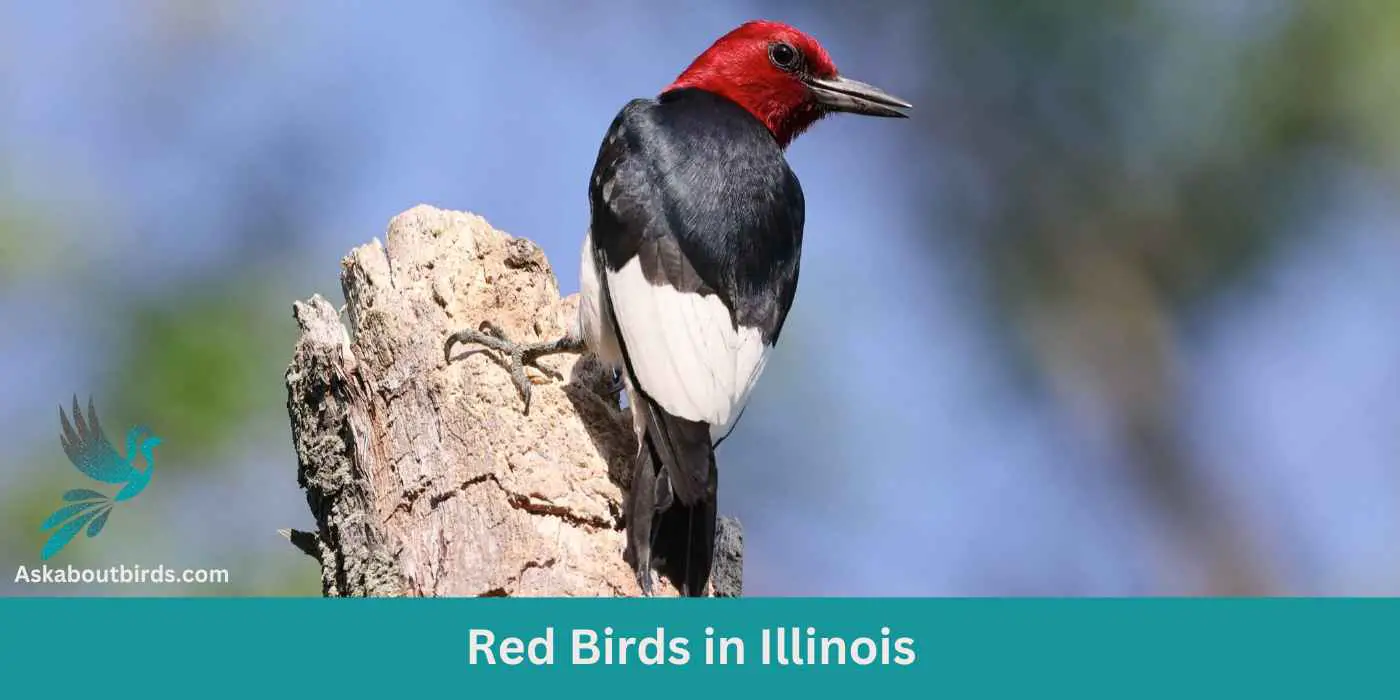From the bustling streets of Chicago to the serene prairies of the heartland, Illinois is not just a hub of cultural marvels but also a haven for avian wonders. Boasting a rich diversity of habitats, the state is home to a stunning array of bird species, with the red-feathered ones often stealing the show.
Join us on a journey through the Land of Lincoln as we introduce you to 11 exquisite red birds that grace its skies and woodlands, complemented by our captivating free photo guide to enhance your birdwatching adventures.
Red Birds Found In Illinois
Illinois, characterized by its rolling hills, fertile plains, and meandering rivers, is a geographic tapestry in the heart of the Midwest.
With its extensive prairies, dense woodlands, and strategic location along the Mississippi flyway, Illinois serves as both a permanent home and a migratory stopover for countless bird species.
Northern Cardinal


| Feature | Measurement |
|---|---|
| Scientific Name | Cardinalis cardinalis |
| Length | 8.3 – 9.1 in |
| Wingspan | 9.8 – 12.2 in |
| Weight | 1.19 – 2.29 oz |
The Northern Cardinal is an iconic North American bird, easily recognized by its vibrant color and melodious song.
Appearance: Male Northern Cardinals are a brilliant scarlet red, while females display a more subdued reddish olive. Both sexes have a distinctive black ‘mask’ on their face around the bill and a pointed crest on their head. The bird’s beak is robust, cone-shaped, and bright orange in color.
Diet: Northern Cardinals are primarily granivorous, with a diet largely consisting of seeds and grains. They also eat fruits and insects. These birds typically feed off the ground and are frequent visitors to bird feeders.
Reproduction: Northern Cardinals are monogamous, and a pair will breed together for life. The female typically builds a well-hidden nest in a dense thicket or shrub. She lays 2-5 eggs per clutch, which she incubates for around two weeks.
Red-bellied Woodpecker
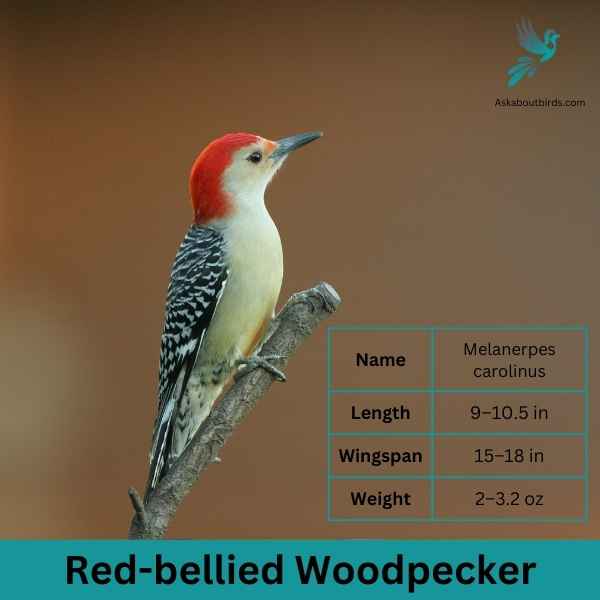
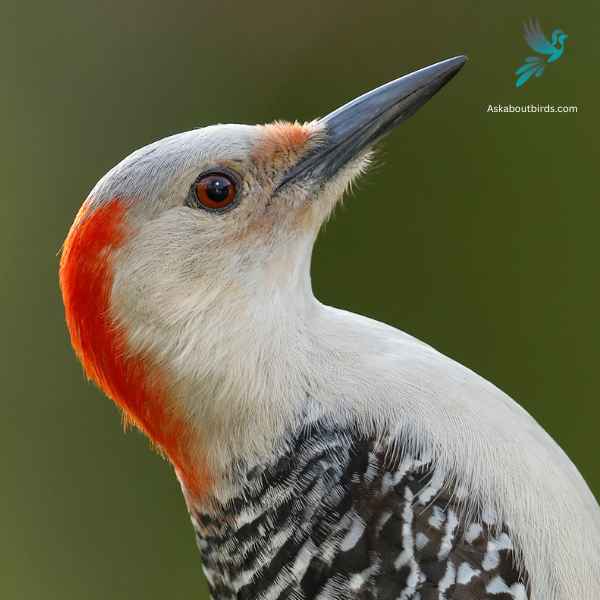
| Feature | Measurement |
|---|---|
| Scientific Name | Thryothorus ludovicianus |
| Length | 4.7–5.5 in |
| Wingspan | 11 in |
| Weight | 0.63–0.81 oz |
The Red-bellied Woodpecker is a medium-sized woodpecker commonly found in woodlands, forests, and backyards across the eastern and central U.S.
Appearance: The Red-bellied Woodpecker sports a pale gray face, throat, and belly, contrasted by a zebra-striped back. Its name derives from the subtle reddish tinge on its belly, but it’s more commonly recognized by the vivid red cap on the head of males and the partial red cap on females.
Diet: This woodpecker has a varied diet that includes insects, fruits, nuts, and seeds. They frequently forage on tree trunks and branches, using their sticky, barbed-tipped tongue to extract ants, beetles, and other insects from crevices.
Reproduction: Red-bellied Woodpeckers are cavity nesters, excavating holes in tree trunks for their nests. The inside of the nest is typically unlined or sparingly lined with wood chips.
Red-headed Woodpecker

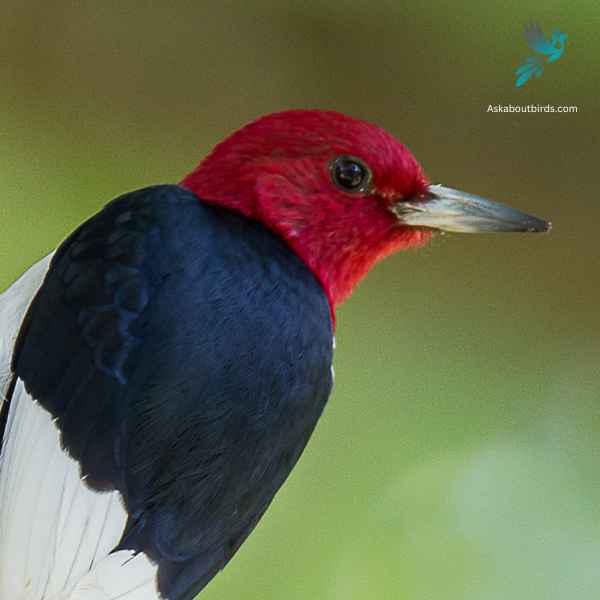
| Feature | Measurement |
|---|---|
| Scientific Name | Melanerpes erythrocephalus |
| Length | 7.5–9.1 in |
| Wingspan | 16.5 in |
| Weight | 2.0–3.2 oz |
The Red-headed Woodpecker is a striking forest bird with a bold tri-colored pattern.
Appearance: This woodpecker features a completely red head and neck, contrasting starkly with its white underparts and black wings. Its wings also have large white patches which are conspicuous in flight.
Diet: Red-headed Woodpeckers have a varied diet including insects, seeds, fruits, berries, and occasionally even the eggs of other birds. They’re also known to store food by wedging it into crevices in bark.
Reproduction: These woodpeckers nest in cavities which they excavate in dead wood or dead parts of live trees. These cavities can be found anywhere from 2 to 80 feet off the ground.
Scarlet Tanager


| Feature | Measurement |
|---|---|
| Scientific Name | Piranga olivacea |
| Length | 6.3 to 7.5 in |
| Wingspan | 9.8 to 11.8 in |
| Weight | 23.5 to 38 g |
The Scarlet Tanager is a strikingly colorful bird known for its brilliant plumage and distinctive song.
Appearance: Male Scarlet Tanagers are notable for their vibrant scarlet bodies contrasted with black wings and tail, making them one of the most intensely colored birds. Females and juveniles, on the other hand, have a subdued olive-yellow body color with darker wings and tail.
Diet: The diet of the Scarlet Tanager is largely made up of insects, including beetles, cicadas, aphids, and others. They are adept flycatchers, seizing insects in mid-air or picking them off foliage. They also consume fruits and berries, especially during migration and in their winter habitats.
Reproduction: The female Scarlet Tanager builds a cup-shaped nest using twigs, rootlets, and grass, typically well-hidden in the dense foliage of trees. She lays 3 to 5 eggs and incubates them for about two weeks.
Summer Tanager


| Feature | Measurement |
|---|---|
| Scientific Name | Piranga rubra |
| Length | 6.7 in |
| Wingspan | 28 to 30 cm |
| Weight | 29 g |
The Summer Tanager is a medium-sized songbird admired for its radiant plumage and melodious song.
Appearance: Male Summer Tanagers are an impressive bright red, while females and juveniles present a softer, yellow-orange color. Both genders have a large, slightly hooked bill and relatively short tail.
Diet: Summer Tanagers primarily feed on insects, including bees and wasps, which they catch in flight or pick off vegetation. They are also known to eat fruits and berries, making them helpful in controlling pest populations and seed dispersal.
Reproduction: The female Summer Tanager builds a loose, shallow cup-shaped nest out of twigs and grass, usually hidden in the foliage of trees. The female typically lays 3-5 eggs, which she will incubate for about two weeks.
House Finch


| Feature | Measurement |
|---|---|
| Scientific Name | Haemorhous mexicanus |
| Length | 5–6 in |
| Wingspan | 8–10 in |
| Weight | 0.6–0.9 oz |
The House Finch is a small songbird widely distributed across North America and is commonly found in urban and suburban areas.
Appearance: Males of this species are brightly colored with crimson faces and throats, which can extend to the chest and back, while their flanks have streaks. The female is streaked brown and lacks the red coloring. Both have a square-tipped tail and a distinctively long, flat-topped bill.
Diet: House Finches primarily eat seeds, grains, and berries. They have a particular fondness for sunflower seeds and can be commonly seen at bird feeders. Occasionally, they will also consume insects, especially during the breeding season.
Reproduction: House Finches are cavity-nesters and might choose ledges, vents, ledges, and other urban settings. They might also utilize trees or shrubs. Their nests can be made of a wide array of materials, from feathers to twigs.
Red Crossbill
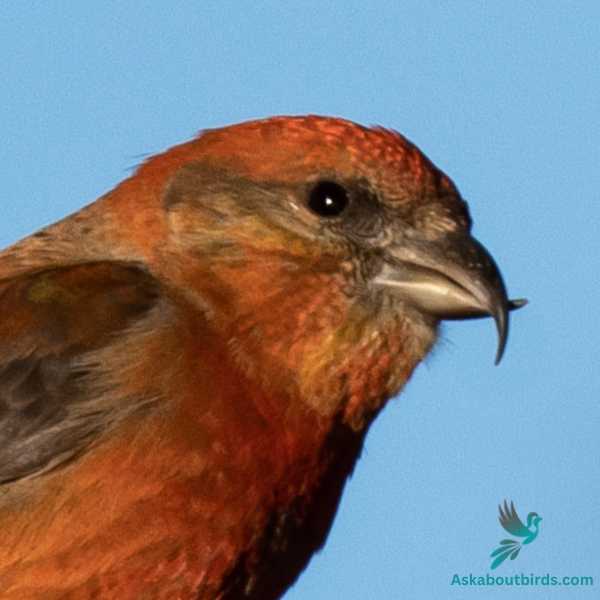

| Feature | Measurement |
|---|---|
| Scientific Name | Loxia curvirostra |
| Length | 20 cm |
| Wingspan | 27–29 cm |
| Weight | 40-53 g |
The Red Crossbill is a peculiar bird species, celebrated for its unique beak structure and vibrant coloration.
Appearance: Red Crossbills are named for their distinctive crossed mandibles, which are adapted to extracting seeds from conifer cones. Male Red Crossbills are usually bright red or orange, while females and juveniles are greenish-yellow. All have dark wings and notched tails.
Diet: The diet of the Red Crossbill is primarily composed of conifer seeds, their unique beak allowing them to access these seeds with ease. This diet includes seeds from pine, spruce, and other types of coniferous trees. They are also known to consume some insects.
Reproduction: Red Crossbills are known for their flexible breeding season, which can occur any time of the year when there is an abundance of food. They typically nest in conifers, where the female lays a clutch of 3 to 4 eggs.
Pine Grosbeak

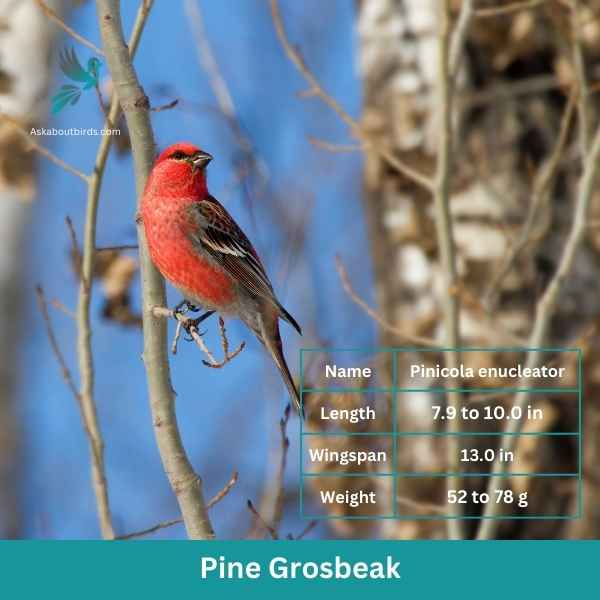
| Feature | Measurement |
|---|---|
| Scientific Name | Pinicola enucleator |
| Length | 7.9 to 10.0 in |
| Wingspan | 13.0 in |
| Weight | 52 to 78 g |
The Pine Grosbeak is a striking bird native to the northern regions of North America, often found in coniferous forests. Both males and females have a plump and robust body with a large beak adapted for eating seeds. The male Pine Grosbeak displays a vibrant reddish-pink plumage, while the female has a more subdued grayish-brown coloration.
These birds are typically seen in small flocks, foraging for food in trees and on the ground. They have a preference for seeds, particularly those from various conifer species. The Pine Grosbeak uses its strong bill to crack open the cones of tall trees and extract the seeds, but they also consume berries and small fruits when available.
White-winged Crossbill


| Scientific Name | Length | Wingspan | Weight |
|---|---|---|---|
| Loxia leucoptera | 6-6.7 in | 9.8-11 in | 0.88-1.23 oz |
The White-winged Crossbill is an intriguing bird known for its unique beak adaptation that helps it extract seeds from conifer cones.
Appearance: This bird boasts a striking color pattern, with males primarily rose-red and females being yellowish-olive. Both sexes, however, exhibit two prominent white wingbars, which give them their name.
Diet: White-winged Crossbills primarily feed on the seeds of spruce and other conifers. Their uniquely shaped beak allows them to pry open conifer cones and extract seeds with great efficiency.
Reproduction: These birds nest in conifers, with the female building a shallow cup-shaped nest. The female typically lays a clutch of 3 to 5 eggs and incubates them for about 12 to 14 days.
Painted Bunting
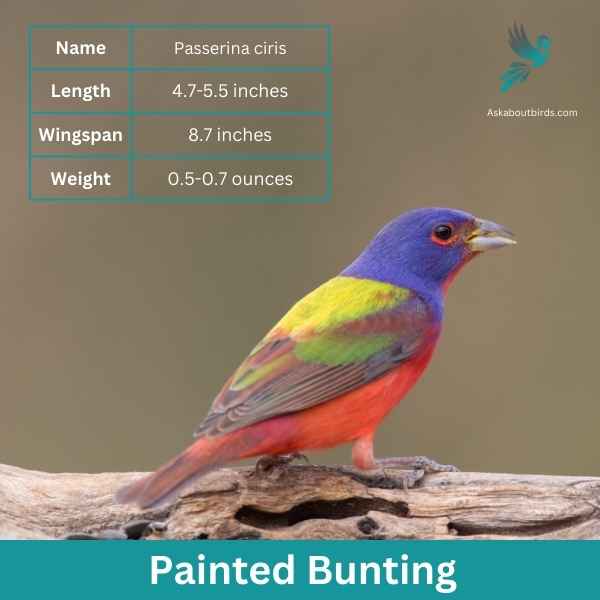
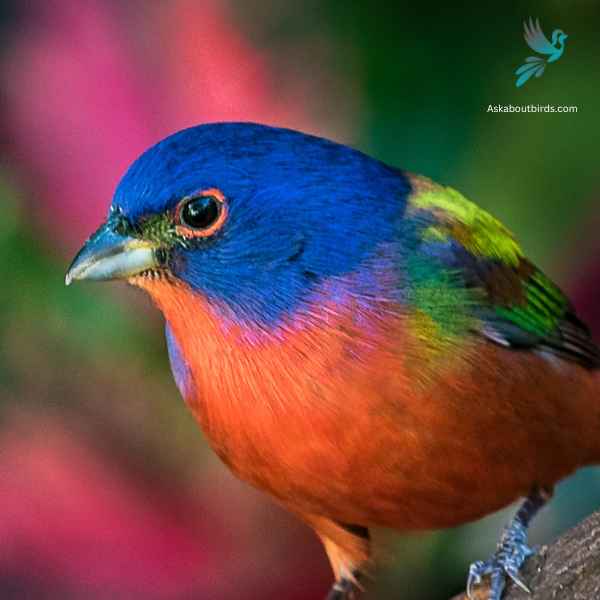
| Feature | Measurement |
|---|---|
| Scientific Name | Passerina ciris |
| Length | 4.7-5.5 inches |
| Wingspan | 8.7 inches |
| Weight | 0.5-0.7 ounces |
The Painted Bunting is often regarded as one of North America’s most dazzling songbirds, attracting birdwatchers and nature enthusiasts with its vibrant colors.
Appearance: Male Painted Buntings boast a breathtaking blend of colors: a bright blue head, red underparts, and green back. Females and juveniles, however, sport a more uniform green-yellow plumage. Despite the male’s eye-catching appearance, these birds can be elusive, often preferring to stay hidden in shrubs and thickets.
Diet: These birds are primarily seed eaters, favoring seeds of native grasses. They also consume insects, especially during the breeding season, which provides the necessary protein for their young.
Reproduction: Painted Buntings often nest in dense cover, usually in shrubs or trees. The female selects the nesting site and constructs the nest, which is typically a cup-shaped structure made of grasses and spiderwebs.
Hepatic Tanager
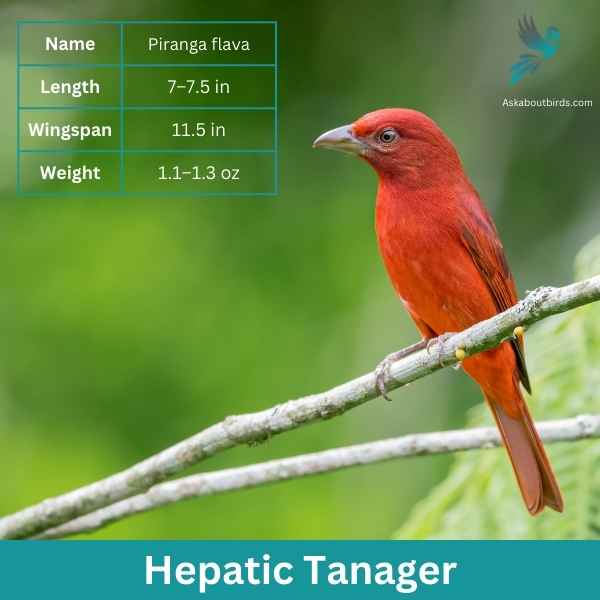
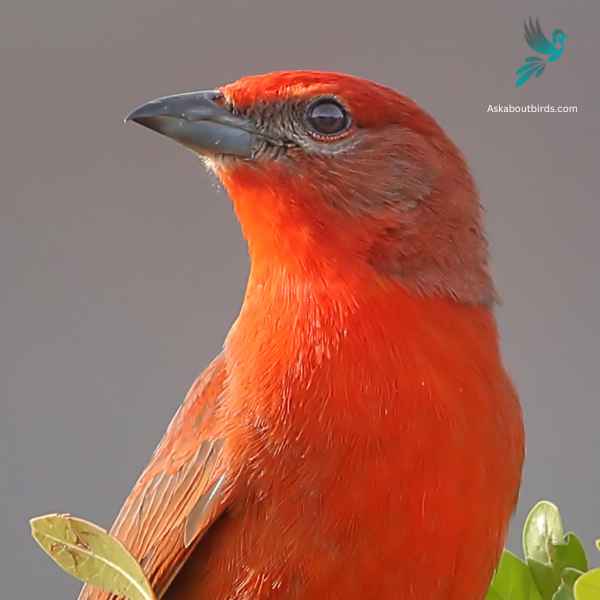
| Feature | Measurement |
|---|---|
| Scientific Name | Piranga flava |
| Length | 7–7.5 in |
| Wingspan | 11.5 in |
| Weight | 1.1–1.3 oz |
The Hepatic Tanager is a robust and brightly colored songbird found primarily in pine-oak woodlands of the American Southwest and Mexico.
Appearance: Male Hepatic Tanagers are a rich reddish-brown or “liver” color, from which they get their name (hepatic means liver-colored). Their wings and tail are more dusky, while females are a more muted yellow-orange, with a gray back and wings. Both sexes have a stout, pointed bill.
Diet: These tanagers primarily eat insects, but they also consume a fair amount of fruit and berries. They often forage by perching quietly and then making short flights to capture prey or pluck fruit.
Reproduction: Hepatic Tanagers nest in trees, often in a concealed location such as a dense clump of needles in a pine tree. The nest is a shallow cup made of twigs, grass, and pine needles. The female typically lays a clutch of 3 to 4 pale blue or greenish eggs. Both parents share feeding duties once the eggs hatch.
Where to Spot Illinois’ Red Birds
Diverse and rich in avian life, Illinois offers several prime bird-watching locations that capture the essence of its ecological beauty.
- Starved Rock State Park: Nestled on the banks of the Illinois River, this park boasts impressive canyons and waterfalls, attracting a wide array of bird species, especially during migration seasons.
- Montrose Point Bird Sanctuary, Chicago: An urban birding gem, Montrose Point is a major stopover for migratory birds. Its dunes, meadows, and shrubs are home to many red bird species.
- Cahokia Mounds State Historic Site: Beyond its historical significance, this site provides a habitat for numerous bird species in its prairies and woodlands, making it a bird-watching haven.
- Emiquon National Wildlife Refuge: Located along the Illinois River, Emiquon is a restored wetland that draws in waterfowl, wading birds, and a diverse range of songbirds.
- Middlefork Savanna Forest Preserve: A pristine tallgrass savanna, this preserve is a hotspot for grassland birds and offers an exceptional birding experience throughout the year.
| State’s Red Birds | Top Spots for Red Birds |
|---|---|
| Indiana’s Red birds | 1. Indiana Dunes State Park 2. Goose Pond Fish & Wildlife Area 3. Eagle Creek Park |
| Iowa’s Red birds | 1. Neal Smith National Wildlife Refuge 2. Ledges State Park 3. Saylorville Lake |
| Missouri’s Red birds | 1. Mingo National Wildlife Refuge 2. Forest Park, St. Louis 3. Prairie State Park |
| Kentucky’s Red birds | 1. Mammoth Cave National Park 2. Red River Gorge 3. Land Between the Lakes National Recreation Area |
| Wisconsin’s Red birds | 1. Horicon Marsh 2. Apostle Islands National Lakeshore 3. Chequamegon-Nicolet National Forest |
FAQs on Red Bird Species Found in Illinois
Which red birds can be commonly spotted in Illinois during the year?
Year round, Illinois residents can frequently observe vibrant red birds like the Rose Breasted Grosbeak and the male House Finch. The former is known for its bright red plumage on the breast, contrasting with greyish white wings, while the latter may display reddish-orange feathers, especially around the head. Both of these stunning birds can be seen around backyard feeders, particularly when filled with black oil sunflower seeds.
Are there any red birds in Illinois known for their bright blue heads?
Yes, the Summer Tanager, which can be found in the deciduous and mixed forests of Illinois, is notable for its vibrant red plumage combined with bright blue heads in some adult males. These birds breed in the southern and eastern states, including Illinois, and are especially attracted to fruit trees and berry bushes.
What habitats in Illinois are ideal for spotting red birds with white wing bars?
Birds like the Purple Finch and the Pine Grosbeak, which display white wing bars and reddish-orange feathers, often prefer forest edges and the forest canopy. Specifically, these birds are drawn to deciduous and mixed forests abundant with oak trees and pine cones. Residents can attract them to their backyards by setting up bird feeders filled with black oil sunflower seeds and by maintaining fruit-bearing plants.
Do any completely red birds migrate to Illinois during the winter months?
Yes, the Summer Tanager, recognized for its completely red body in adult males, migrates to the southern and eastern states, including Illinois, during the warmer months. However, during the winter months, these birds typically travel further south, heading to Central and South America. Those keen on spotting these birds should visit areas with fruit trees and berry bushes during the migration season.

